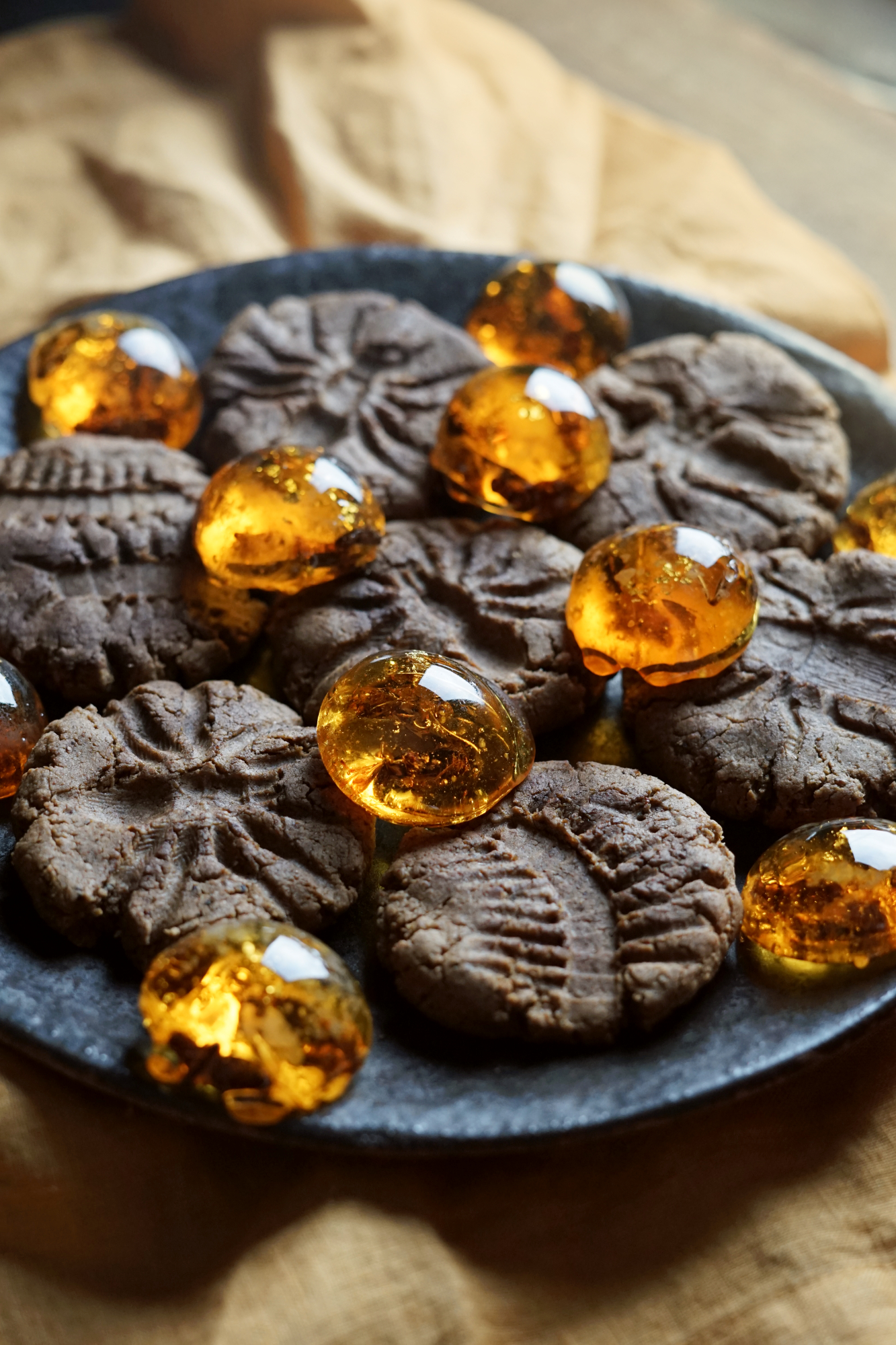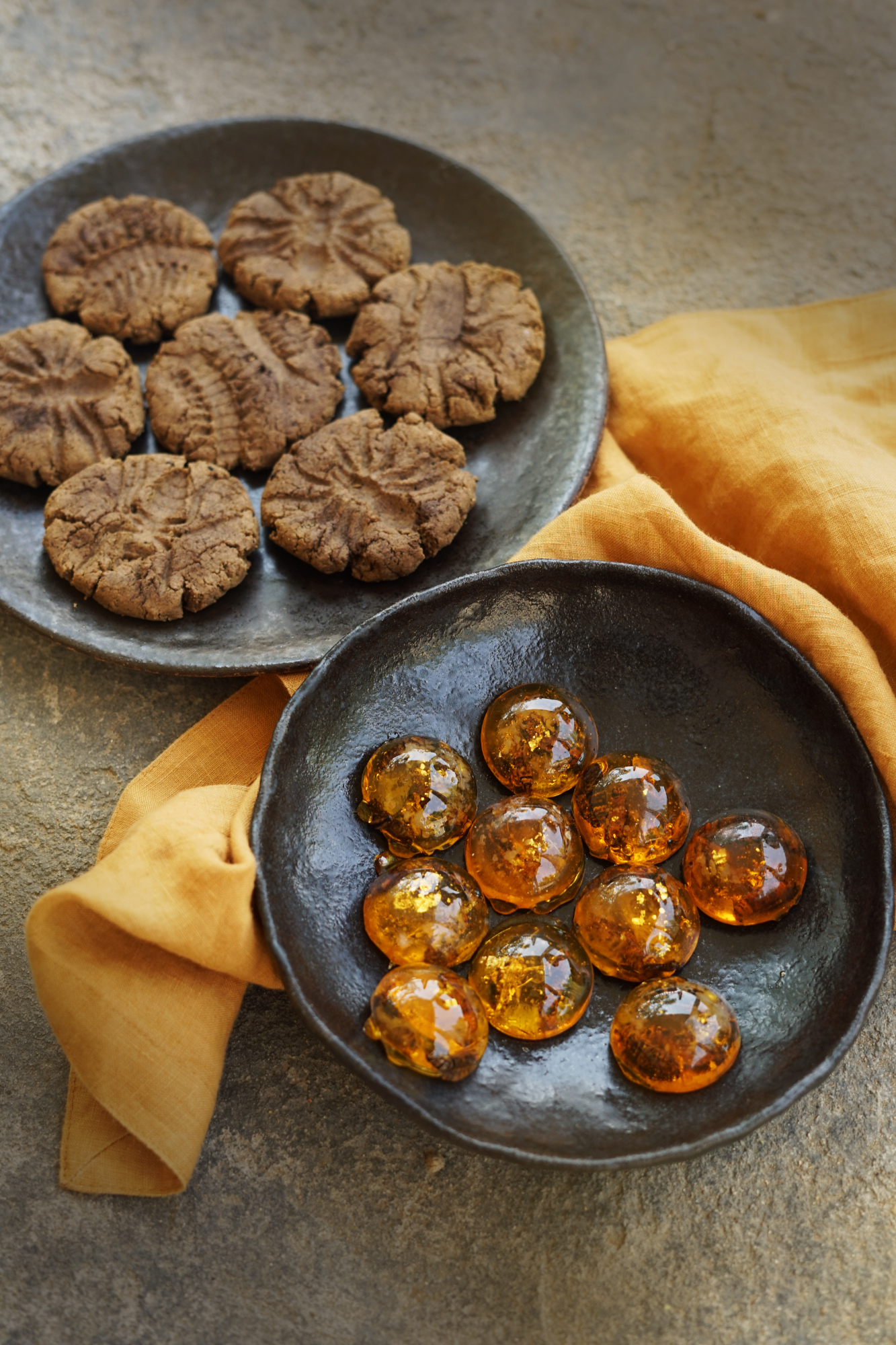Amber Candy and Fossil Cookies: The Evolutionary Dance of Entomophagy
There’s something about observing a fossil that leads me to a wonderful kind of lostness; thinking about the grand scale of time reminds me that I am but one tiny speck in the history of rich life on this planet, that human history itself is barely a breath in the geologic time span of our planet. But even so, our lives are like eons compared to the lives around us; the insects that thrive in such vast populations but know only a few days or weeks of life compared to our many years. The world hums with tiny winged creatures living in tandem with us. It’s good to zoom out sometimes and think about the space we inhabit both in a physical sense and in the jumble of time. We are not constant, but are inextricably linked to the billions of years of life that came before us and will (hopefully) continue long after we are gone.
Let’s talk about entomophagy. It may seem like an odd jump to transition from fossils and the grand scale of life to the practice of eating insects, but bear with me. Insects have accompanied us on our dance through the ages, impacting our populations and even our evolution. Though their individual lifespans are short compared to ours, the timeline of insects is far longer than our own. Bugs have been around a lot longer than we have. It’s estimated that insects originated on earth about 480 million years ago (well, depending on what you call a “bug.”) The insect fossil record extends back about 400 million years preserved in amber and sedimentary rock, long before we were even a rough draft. (In contrast, our Homo sapiens ancestors weren’t around until about 300-130 thousand years ago.) Insects evolved at about the same time as plants, dancing with them through the ages. Together, they learned to interact with one another as insects learned to pollinate and dine on the sweet nectar that the plants evolved to offer them. These symbiotic relationships shaped the world into what we know today. When we eventually joined their long established dance, we had to quickly learn the steps. Our ancient ancestors navigated their way through the world, evolving along with our surroundings. We learned to forage the plants that surrounded us and eventually learned to cook them too. We observed other animals eating insects and decided that perhaps, in our ever-curious omnivore nature, we should try them too.
Historically, our ancestors have been eating insects as food for thousands of years. In fact, insects were often seen as great delicacies in ancient cultures! Cicadas were a treasured specialty in ancient Greece, while Romans delighted in dining upon beetle larvae. Even the Bible weighs in on entomophagy; in Leviticus 11:22, it says "Even these of them ye may eat; the locust after his kind, and the bald locust after his kind, and the beetle after his kind, and the grasshopper after his kind." John the Baptist lived in the desert for months at a time, living on locusts and honeycomb. Why, then, do we have such a disgust reaction to the thought of eating bugs today? The thought of eating insects reminds us more of dares and punishment than wholesome family meals, which is strange because entomophagy is still a common practice in most of the world today.
But now that our ever-changing planet is facing the challenges of a rapidly-growing population, we need to once again get creative with the way we source our food. Raising insects is far more efficient than raising beef or pork or chicken; one pound of protein from crickets takes approximately twenty times less resources to produce than beef. Insect farms can be compact and insects can be fed on compost and other waste. Insects are good for you, too - crickets are one of the most efficient protein sources on earth. (A dry cricket is 65-70% pure protein, while beef is between 17-40% protein.) Cricket powder contains all the essential branched-chain amino acids that the human body needs for muscle development. It’s also packed with vitamins and minerals, including lots of iron and Vitamin B12. Lastly, insects are tasty! Ants have a sour tanginess, mealworms are buttery, and crickets and grasshoppers have a subtle nuttiness that’s easy to incorporate into a variety of recipes. (If you’d like to try some yourself, I recommend Cricket Flours, a Portland company that carries a great line of cricket flours and products. Huge thanks to them for sending me some samples and sponsoring this post!) With a growing population, entomophagy is looking more and more like a sustainable (and sustaining) option.
The only thing standing between us and a future of wholesome insect-based meals is our cultural programming. And the good news is, that can change. It was only a couple of generations ago that the thought of eating raw fish was met with disgust here in the USA, but now sushi is a popular meal. Though lobster was once viewed as a low-quality filter feeder unfit for human consumption, it now fetches top prices at gourmet restaurants and is seen as a luxurious specialty. (And really, if you think about it, lobsters are just giant sea bugs.) I have hope that insects will soon be seen as a healthy, sustainable, and, dare I say it, even delicious option in the near future. But we need to start slow. Not many people in our North American culture would happily eat a big plate of bugs placed in front of them. But perhaps they’d try a delicious cookie made from protein-rich cricket flour! You may not want to slurp down beetles, but would you try a crunchy and sweet chunk of edible amber?
That brings me back to the wonder of fossils, those preserved remains of life far older than we can really even comprehend. They remind us that our evolutionary dance is not done solo; instead both our history and our present lives are intertwined with billions of other organisms and species. We hold a responsibility to our dance partners to consider their role in our journey. One way to do that is to sidle towards more sustainable practices that will allow them to continue their evolution far into the future. Maybe someday future geologists will discover the fossilized remains of the grasshoppers we snacked on around a campfire. Maybe they’ll find a fossilized fossil cookie that will utterly confuse them. But in any case, now is a great time to become re-acquainted with the ancient practice of entomophagy with some delectable fossil-inspired buggy treats.
Cricket Fossil Cookies:
These protein-rich cookies are gluten-free, dairy-free, and refined sugar free. They are super filling and energizing and can be eaten more like an energy bar than an after-dinner treat. I first got the idea for fossil cookies from Martha Stewart but thought it’d be more appropriate to fill them with insect protein than with lots of butter and sugar. They get their fat instead from sunflower seed butter, which was often used by Native Americans as a flavoring or condiment. These cookies are lightly sweet and very nutty. They taste wholesome and hearty, and would be great served with some homemade plum jam, caramel sauce, or soft goat cheese! They are a wonderful introduction to entomophagy as the cricket powder blends seamlessly into the nutty sweet cookie flavor. (In fact, if you’re looking for a way to deliver protein to picky kiddos, this might just be the ticket!) You can dust them with black cocoa powder after baking for a little extra definition in your designs.
Ingredients:
1/2 c. white rice flour
1/3 c. acorn flour (or almond flour)
1/2 c. tapioca starch
pinch xantham gum
1/2 tsp. baking soda
pinch salt
1/2 tsp. cinnamon
4 Tbs. honey
2/3 c. sunflower seed butter (or peanut butter)
1/2 tsp. vanilla
1tsp. maple extract
1 Tbs. vegetable oil
1-2 Tbs. water, if needed
Directions:
- Preheat the oven to 325 F. Sift all of the dry ingredients together. In a separate bowl, mix all of the wet ingredients except for the water. Stir in to the dry ingredients. If the dough is too dry, add a little water.
- Roll into balls, then place on a greased or parchment-lined cookie sheet and flatten to about 1 cm thick with your palms. Press a clean plastic insect into the surface to make an indentation (or draw the designs in with a chopstick.)
- Bake for 20 minutes and allow to cool on pan.
Amber Candy:
These sweet confections look like the real deal: it’s amazing how much cooked caramel candies resemble amber! The addition of real roasted crickets make them barely-distinguishable from the fossilized tree sap. Sweet, crunchy, and just a bit salty, they’re a great next step into the wonderful world of entomophagy. (Also, the ingredients designated with an * are affiliate links. That means if you purchase something after clicking them, I may earn a small commission at no extra cost to you. Learn more here.)
Ingredients:
4 oz water
8 oz sugar
pinch of salt
kitchen torch (optional)
Directions:
- Prepare your work station by setting out the candy mold, a small bowl of roasted crickets, and the edible gold leaf and a few toothpicks.
- In a small pan, combine the sugar, water, and salt. Put over medium heat and just let it cook - don’t stir or you could risk the caramel seizing up and crystalizing.
- Keep a close eye on the mixture, since it will go from a light caramel to a burned glob very quickly. Let it simmer until it takes on a light caramel color, tilting the pan gently every now and then to swirl and get a sense for the color. Once it’s golden, remove from heat.
- Pour the caramel into the molds, filling them 1/3 of the way. Set the caramel aside. Working quickly, sprinkle a few crickets into each mold. Use toothpicks to dab edible gold leaf around the crickets. Top the candies with more caramel. (If it gets too sticky, just place back over the heat until it’s softened enough to pour again.) Let cool and harden.
- Remove the cooled candies from the molds. If the surface is cloudy, you can clarify it by gently going over the surface with a kitchen torch. Some of the candies might crack but that’s okay, the heat will fuse them back together. Let cool again.
- Store the caramels in an airtight container or eat immediately.
- Here’s a tip on using up that extra caramel: place the pot back over low heat until the caramel becomes fluid again. Add about a cup of heavy cream or coconut cream and mix, then cook until smooth and slightly thickened. You may need to strain out stray bug bits! Now you have a delicious caramel sauce to serve over ice cream or dip cookies into.
I hope you’ve enjoyed this post about fossils and eating bugs! Don’t forget to check out Cricket Flours if you’d like to get your own bag of nutritious and nutty cricket powder. Have you ever eaten insects? I’d love to hear about your experience in the comments below!
Also, this post is free to you thanks to the support of my generous patrons. For as little as $1 a month, you can help support my mission to spread wonder far and wide... and get some fun rewards too. Learn more on my Patreon Page.




















Join me for a little winter night magic as we bake this cake full of rich seasonal flavors and black cocoa!